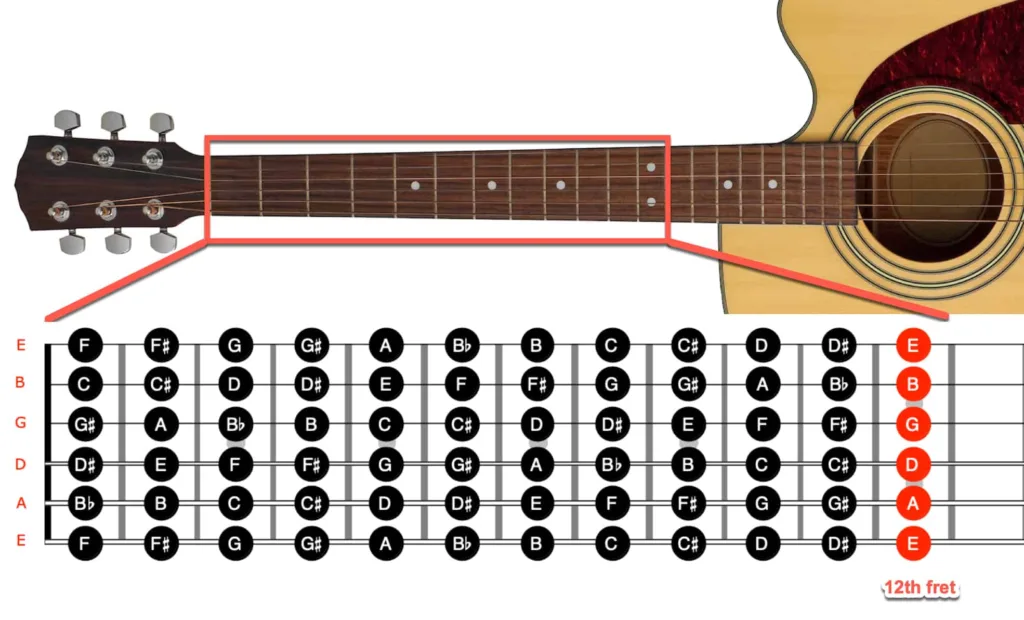Have you ever picked up an acoustic guitar and wondered, “how many frets does this thing actually have?” I know I did when I first started learning to play. With so much information out there about guitars, it can be overwhelming for beginners to know where to start.
That’s why in this article, I’ll guide you through everything you need to know about the number of frets on an acoustic guitar. From what a fret is and how they are numbered, to the differences between different types of guitars, we’ll cover it all. So whether you’re just starting your guitar journey or looking to expand your knowledge, keep reading for all the answers!
So, how many frets on an acoustic guitar?
An acoustic guitar typically has 20-22 frets, but some models may have up to 24 frets. The number of frets on a guitar is important for beginners to understand as it affects the range and versatility of the instrument.
Frets are the metal bars that run perpendicular to the strings on a guitar’s neck. They divide the neck into different sections, allowing players to create different notes by pressing down on them with their fingers.
The more frets a guitar has, the higher its pitch range will be. This means that guitars with more frets can produce higher-pitched notes and play songs in a wider variety of keys. However, having too many frets can also make it difficult for beginners to learn how to play chords and navigate the neck comfortably.
It is common for acoustic guitars to have between 20-22 frets because this provides a good balance between range and ease of playing. Most beginner-friendly songs can be played within this range without needing additional frets.
Some advanced players may prefer guitars with more than 22 frets as it allows them to explore new sounds and techniques. However, these types of guitars are not necessary for beginners who are just starting out.
Ultimately, when choosing an acoustic guitar as a beginner, focus on finding one with good sound quality and comfortable playability rather than solely considering the number of frets it has. With practice and dedication, you can learn how to make beautiful music regardless of how many or few frets your guitar has.
Understanding Guitar Frets: Their Purpose and Importance
When you first lay eyes on a guitar, one of the most distinctive features you’ll notice is the series of metal strips running across the neck. These are known as frets, and they play a crucial role in making music with this beloved instrument. Without them, it would be nearly impossible to create precise notes or chords. Each fret represents a different note when your finger presses down on it; therefore, knowing where each fret is helps orchestrate melodies.
To understand their importance more deeply, let’s imagine playing a guitar without any frets. It would mean depending entirely on your ear for accuracy – which could lead to discordant tunes if your pitch recognition isn’t perfect! In contrast, with frets as guides:
- You can pinpoint exactly where to place your fingers.
- You have consistent reference points for learning scales and chords.
- Playing becomes easier because strumming at specific points will always produce the same sound.
Whether performing an intricate solo or just jamming out some simple chords at home, having well-defined spaces (frets) contributes significantly to creating harmonious music. Therefore, understanding how these little metallic bars function forms an essential part of mastering not only guitars but pretty much every stringed musical instrument out there! So next time you pick up that six-string beauty, take a moment to appreciate those shiny little life lines running along its neck!
The Typical Number of Frets on an Acoustic Guitar: A Detailed Look
Understanding the Acoustic Guitar
The first thing that catches your eye when you look at an acoustic guitar is its striking wooden body, but upon a closer look, you’ll quickly notice the metallic strings and frets running along its neck. The number of these ‘frets’ might seem random to someone who’s uninitiated, but there’s actually a typical standard when it comes to acoustic guitars. Most full-size acoustic guitars have 20 frets. This count offers sufficient range for both beginners and proficient players to explore various tunes.
The Role of Frets in Sound Production
Now let’s dive into why these frets matter so much in music creation. Each individual fret on an acoustic guitar corresponds to a specific pitch or note- pressing the string against different frets manipulates this pitch. Here are few key things about them:
- Frets are sequentially spaced – each one getting slightly closer together as they near the sound hole.
- The 12th fret typically divides the string exactly into half and produces what is called an octave above open-string pitch.
- Certain tones require specific finger placements across multiple strings & several different frets – hence having multiple options (frets) allows for greater musical diversity!
And there you have it! Your friendly introduction to understanding how many outlets for melody – otherwise known as ‘frets’, most commonly exist on an acoustic guitar.
Read also: did jimi hendrix play the guitar upside down
Different Types of Acoustic Guitars and their Number of Frets: Diverse Designs for Various Sounds
When you think about acoustic guitars, the variety of designs available might surprise you. It’s quite fascinating how seemingly small differences, such as the number of frets or type of body design, can significantly influence the sound and playability of these time-honored instruments.
For instance, let’s take a look at two popular types: dreadnought and parlor.
- The dreadnought, characterized by its larger body and typically featuring 20 frets, is known for producing a robust, resonant sound that makes it perfect for bold strumming in genres like rock or country.
- The smaller parlor guitar, on the other hand, usually has fewer frets (around 18 to 19) and sports a more slender shape. This design results in a softer tone that lends itself beautifully to fingerstyle playing or folk music.
Different acoustic guitars cater to various musical tastes with an array of sounds produced by their unique construction components. The distinct character each type brings forth underscores one crucial fact – no single guitar style fits all!

How the Amount of Guitar Frets Influence Your Playing Style and Sound Quality
Understanding The Impact of Guitar Frets
As a guitar player, you might be surprised at how much the number of frets on your instrument can influence both your playing style and sound quality. The number of frets determines the range of notes that you can play, which directly impacts what chords and melodies are accessible to you. A standard guitar typically has 22 or 24 frets, but some special versions even go up to 27!
If we take a closer look:
- 22-fret guitars: These are classic in nature and often used for genres such as blues or jazz. They provide a warm tone that’s perfect for those slow, soulful solos.
- 24-fret guitars: Often found on modern models aimed towards rock or metal players who crave extra high notes for blistering solos.
- Guitars with more than 24 frets: These specialty instruments allow for an even wider note range – ideal if you’re into experimental music styles, always looking to push boundaries!
The Connection Between Frets And Sound Qualit
The amount of frets doesn’t just affect the range – it also profoundly affects the overall sound quality. For example, a longer neck with more frets generally results in a brighter tone, because there’s more string length between the bridge and nut allowing free vibration creating higher frequencies. Conversely, shorter necked guitars like those with only 19-20 frets often offer deeper tones due to less string length vibrating.
Beyond these inherent tonal characteristics associated with different numbers of guitar fretts—choosing an instrument should ultimately reflect your unique musical taste and individual playing style preferences.
You may also like: gh1 yamaha piano price
How Understanding the Number of Guitar Fret Helps Enhance Your Music Experience.
The beauty of guitar playing lies not only in the melodious sounds that strike a chord with your soul but also in understanding its structure. When you grasp the basic concept of how frets on a guitar work, this can truly elevate your music experience. The number of frets on a guitar typically ranges between 19 to 24, with each one responsible for producing different pitches when struck. Knowing and mastering these pitches is like learning an entirely new language – one that communicates through tunes and rhythms.
Dig deeper, and you’ll realize each fret corresponds to every half-step or semi-tone along the chromatic scale, which is fundamentally important in Western music theory. These are some fascinating insights:
- The first fret produces a sound exactly one semitone higher than an open string.
- Moving up by twelve frets raises the pitch by an octave — essentially creating identical notes at double frequency.
- In addition to changing note pitch, skilled players use techniques such as bending (changing tone by pressuring strings), vibrato (oscillating pitch) or sliding (gliding from one tone to another).
Simply put, having more frets allows for added musical range enhancing creativity while composing or covering songs. Aspiring musicians often underrate this understanding about their instrument’s anatomy, dismissing it as mere technical jargon. But once they begin appreciating these details, their relationship with music deepens making every performance feel more personal and gratifying.
In conclusion: knowing your way around those silver streaked lines can indeed be instrumental (pun intended!) in enhancing your overall musical journey!

